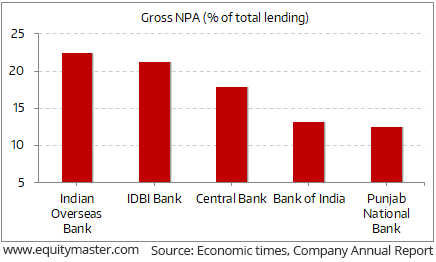- Home
- Todays Market
- Indian Stock Market News August 3, 2017
Indian Indices Extend Losses; Banking Sector Down 1.2% Thu, 3 Aug 11:30 am
After opening the day marginally lower, Indian share markets witnessed further losses and went on to trade in the red. Sectoral indices are trading on a negative note with stocks from the metal sector and the banking sector witnessing maximum selling pressure.
The BSE Sensex is trading down 145 points (down 0.5%) and the NSE Nifty is trading down 39 points (down 0.4%). Meanwhile, the BSE Mid Cap index is trading up by 0.1%, while the BSE Small Cap index is trading down 0.3%. The rupee is trading at 63.68 to the US$.
The RBI, after identifying 12 large accounts for resolution under the bankruptcy code, is likely to take more such steps to tackle the bad loan problem in India.
This comes as the RBI Governor Urjit Patel said that the government and the RBI are working in close coordination to resolve large stressed corporate borrowers and recapitalize PSBs within the fiscal deficit target.
The bad loans at Indian banks have only been rising, as can be seen from the chart below:
Rising Bad Loans at Indian Banks
Just Released: Multibagger Stocks Guide
(2017 Edition)
In this report, we reveal four proven strategies to picking multibagger stocks.
Well over a million copies of this report have already been claimed over the years.
Go ahead, grab your copy today. It's Free.

Gross non-performing assets (GNPA) of Indian banks rose from 9.2% in September 2016 to 9.6% in March 2017. GNPA refers to the total value of loans on which interest and principal income has not been received by the bank for more than ninety days. For some banks, the ratio of GNPAs to total lending is more than 20%. This means more than Rs 20 out of every Rs 100 lent is at the risk of not coming back.
The RBI expects the average GNPA ratio to increase to 10.2% by March 2018. It indicated that if macroeconomic conditions worsen, this number could go up.
The problem of bad loans is indeed quite severe and when we compare it with other global peers it looks daunting.
Out of the ten major economies facing NPA problems, India is ranked seventh.
The overhang of bad debts has not only hit the bank's profitability, but has also restricted their loan book growth.
However, the ongoing developments by the government and the RBI comes as a significant step in the long overdue process of recovery of loans choking the banking system.
Bad loan recovery has gathered momentum after years of hesitation since the government empowered RBI to direct banks to take big defaulters through the process prescribed under the Insolvency and Bankruptcy Code (IBC) that specifies timebound resolution.
In the news from global financial markets, Japan's service sector expanded at a slower pace in July. This came as the Markit/Nikkei Japan Services Purchasing Managers Index (PMI) fell to a seasonally adjusted 52.0 from 53.3 in June.
The above fall was seen as new orders eased in the month of July and signaled that Japan's economic activity may be moderating.
Data showed that growth in new business eased, while companies continued to hire new staff but also at a slower pace.
The above data comes shortly after the final manufacturing PMI which showed Japan's factory activity grew at the slowest pace in eight months.
Taken together, the composite PMI, which includes both manufacturing and services, fell to 51.8 in July from 52.9 in June.
One shall note that there remain many issues that can hamper Japan's economic growth. The economy is flooded with excessive money printing, too much debt, too much government intervention, and stock market manipulation.
The BoJ's moves are in line with the easy money policies that central banks have adopted around the world. However, with the changes at central banks in 2016, it seems that the end of easy money is near.
In the news from GST space, Finance minister Arun Jaitley said there is scope to rationalise GST and rolling 12% and 18% slabs into one as the implementation progresses.
Presently, GST has 5%, 12%, 18% and 28% rates, plus one for luxury and sin goods. Besides, there are some goods that are zero rated, or have a nil rate.
The above proposal, if implemented, will lead to further simplification in the taxation process. How the development pans out remain to be seen. Meanwhile, we'll keep you updated on the recent happenings in the GST space.
Speaking of GST, the Goods and Services Tax became the order of the day last month. And all these months we have been subjected to a relentless propaganda by the government and the supporters of the GST, on how it will change our world, only for good.
Our colleague Vivek Kaul, has studied the finer aspects of the GST and predicted what could go right and wrong.
Download his special report - The Good, the Sad and the Terrible (GST).
For information on how to pick stocks that have the potential to deliver big returns, download our special report now!
Read the latest Market Commentary



Equitymaster requests your view! Post a comment on "Indian Indices Extend Losses; Banking Sector Down 1.2%". Click here!
Comments are moderated by Equitymaster, in accordance with the Terms of Use, and may not appear
on this article until they have been reviewed and deemed appropriate for posting.
In the meantime, you may want to share this article with your friends!